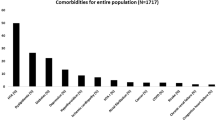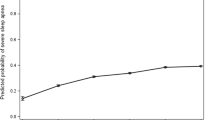Abstract
Purpose
Obstructive sleep apnea (OSA) syndrome is a well-recognized independent risk factor for cardiovascular disease and its prevalence is increasing. OSA symptomology, polysomnographic features, and comorbidities are heterogeneous among patients. Ethnicity is thought to influence OSA phenotypes, but extensive knowledge of OSA ethnic patterns is lacking. The primary aim of the present study was to compare comorbidities in Caucasian and African OSA. Secondary aims were to observe OSA symptomatology, polysomnographic characteristics, and CPAP adherence in these two ethnic groups.
Methods
In this retrospective study, 1717 patients suffering from moderate/severe OSA were included between 2013 and 2017. Data on demographics, symptomatology, comorbidities, polysomnographic characteristics, and CPAP adherence were collected. Data were analyzed to identify potential differences between Caucasians and Africans.
Results
Despite healthier lifestyles and lower BMI, a higher prevalence of diabetes but less cardiac comorbidities and dyslipidemia was observed in the African population. Younger African patients (< 56 years) suffered more from cognitive impairment than Caucasians and both younger and older Africans complained more of nighttime choking than Caucasians. In analysis of polysomnographic data, Africans had higher apnea-hypopnea index (AHI) in REM sleep, lower supine AHI, lower desaturation time, and lower periodic leg movements index.
Conclusions
Compared with Caucasians, African OSA showed a particular comorbidity profile. There are younger patients who exhibit more diabetes but less cardiac comorbidities than the Caucasians. African diabetics should be more promptly referred for OSA testing. Moreover, as they suffer more often from choking and cognitive impairment, OSA treatment could positively impact their quality of life.


Similar content being viewed by others
References
Marin JM, Carrizo SJ, Vicente E, Agusti AG (2005) Long-term cardiovascular outcomes in men with obstructive sleep apnoea-hypopnoea with or without treatment with continuous positive airway pressure: an observational study. Lancet 365(9464):1046–1053
Redline S, Yenokyan G, Gottlieb DJ, Shahar E, O’Connor GT, Resnick HE, Diener-West M, Sanders MH, Wolf PA, Geraghty EM, Ali T, Lebowitz M, Punjabi NM (2010) Obstructive sleep apnea-hypopnea and incident stroke: the sleep heart health study. Am J Respir Crit Care Med 182(2):269–277
Peppard PE, Young T, Barnet JH, Palta M, Hagen EW, Hla KM (2013) Increased prevalence of sleep-disordered breathing in adults. Am J Epidemiol 177(9):1006–1014
Heinzer R, Vat S, Marques-Vidal P et al (2015) Prevalence of sleep-disordered breathing in the general population: the HypnoLaus study. Lancet Respir Med 3(4):310–318
Engleman HM, Douglas NJ (2004) Sleep.4: sleepiness, cognitive function and quality of life in obstructive sleep apnoea/hypopnoea syndrome. Thorax 59:618–622
Loredo JS, Ancoli-Israel S, Dimsdale JE (1999) Effect of continuous positive airway pressure vs placebo continuous positive airway pressure on sleep quality in obstructive sleep apnea. Chest 116(6):1545–1549
Silva GE, An MW, Goodwin JL, Shahar E, Redline S, Resnick H, Baldwin CM, Quan SF (2009) Longitudinal evaluation of sleep-disordered breathing and sleep symptoms with change in quality of life: the Sleep Heart Health Study. Sleep 32:1049–1057
Gay P, Weaver T, Loube D, Iber C (2006) Evaluation of positive airway pressure treatment for sleep related breathing disorders in adults. Sleep 29(3):381–401
Rotenberg BW, Murariu D, Pang KP (2016) Trends in CPAP adherence over twenty years of data collection: a flattened curve. J Otolaryngol Head Neck Surg 45(1):43
Ye L, Pien GW, Ratcliffe SJ, Björnsdottir E, Arnardottir ES, Pack AI, Benediktsdottir B, Gislason T (2014) The different clinical faces of obstructive sleep apnoea: a cluster analysis. Eur Respir J 44(6):1600–1607
Chen X, Wang R, Zee P, Lutsey PL, Javaheri S, Alcántara C, Jackson CL, Williams MA, Redline S (2015) Racial/ethnic differences in sleep disturbances: the Multi-Ethnic Study of Atherosclerosis (MESA). Sleep 38(6):877–888
Berry RB, Budhiraja R, Gottlieb DJ, Gozal D, Iber C, Kapur VK, Marcus CL, Mehra R, Parthasarathy S, Quan SF, Redline S, Strohl KP, Davidson Ward SL, Tangredi MM (2012) Rules for scoring respiratory events in sleep: update of the 2007 AASM manual for the scoring of sleep and associated events. Deliberations of the Sleep Apnea Definitions Task Force of the American Academy of Sleep Medicine. J Clin Sleep Med 8(5):597–619
Kribbs NB, Pack AI, Kline LR, Getsy JE, Schuett JS, Henry JN, Maislin G, Dinges DF (1993) Effects of one night without nasal CPAP treatment on sleep and sleepiness in patients with obstructive sleep apnea. American Rev Respir Dis 147:1162–1168
Frank MH, Ravesloot MJ, van Maanen JP et al (2015) Positional OSA part 1: towards a clinical classification system for position-dependent obstructive sleep apnoea. Sleep Breath 19(2):473–80. 9
Hein M, Lanquart JP, Loas G, Hubain P, Linkowski P (2017) Prevalence and risk factors of moderate to severe obstructive sleep apnea syndrome in insomnia: a study on 1311 subjects. Respir Res 18(1):135
Hall MH, Matthews KA, Kravitz HM, Gold EB, Buysse DJ, Bromberger JT, Owens JF, Sowers M (Jan 2009) Race and financial strain are independent correlates of sleep in midlife women: the SWAN sleep study. Sleep 32(1):73–82
Ruiter ME, DeCoster J, Jacobs L, Lichstein KL (2010) Sleep disorders in African Americans and Caucasian Americans: a meta-analysis. Behav Sleep Med 8(4):246–259
Bruyneel M, Ameye L, Ninane V (2011 Sep) Sleep apnea syndrome in a young cosmopolite urban adult population : risk factors for disease severity. Sleep Breath 15(3):543–548
Basoglu OK, Tasbakan MS (2018) Gender differences in clinical and polysomnographic features of obstructive sleep apnea: a clinical study of 2827 patients. Sleep Breath 22(1):241–249. https://doi.org/10.1007/s11325-017-1482-9 Epub 2017 Feb 14
O’Brien LM, Holbrook CR, Faye Jones V, Gozal D (2007) Ethnic difference in periodic limb movements in children. Sleep Med 8(3):240–246
Alattar M, Harrington JJ, Mitchell CM, Sloane P (2007) Sleep problems in primary care: a North Carolina family practice research network (NC-FP-RN) study. J Am Board Fam Med 2 20(4):365–374
Lee HB, Hening WA, Allen RP, Earley CP, Eaton WW, Lyketsos CG (2006) Race and restless legs syndrome symptoms in an adult community sample in east Baltimore. Sleep Med 7:642–645
Prasad B, Steffen AD, Van Dongen HPA, Pack FM, Strakovsky I, Staley B, Dinges DF, Maislin G, Pack AI, Weaver TE (2018) Determinants of sleepiness in obstructive sleep apnea. Sleep 41(2):zsx199
Baldwin CM, Ervin AM, Mays MZ et al (2010) Sleep disturbances, quality of life, and ethnicity: the Sleep Heart Health Study. J Clin Sleep Med 6(2):176–183
Davidson TM, Sedgh J, Tran D, Stepnowsky CJ Jr (2005) The anatomic basis for the acquisition of speech and obstructive sleep apnea: evidence from cephalometric analysis supports the Great Leap Forward hypothesis. Sleep Med 6(6):497–505
Gunnarsson SI, Peppard PE, Korcarz CE, Barnet JH, Hagen EW, Hla KM, Palta M, Young T et al (2015) Minimal nocturnal oxygen saturation predicts future subclinical carotid atherosclerosis: the Wisconsin sleep cohort. J Sleep Res 24(6):680–686
Aronsohn RS, Whitmore H, Van Cauter E, Tasali E (2010) Impact of untreated obstructive sleep apnea on glucose control in type 2 diabetes. Am J Respir Crit Care Med 181:507e13
Meslier N, Gagnadoux F, Giraud P, Person C, Ouksel H, Urban T, Racineux JL (2003) Impaired glucose-insulin metabolism in males with obstructive sleep apnoea syndrome. Eur Respir J 22:156–160
Bakker JP, Weng J, Wang R, Redline S, Punjabi NM, Patel SR (2015) Associations between obstructive sleep apnea, sleep duration, and abnormal fasting glucose. The multi-ethnic study of atherosclerosis. Am J Respir Crit Care Med 192:745–753. https://doi.org/10.1164/rccm.201502-0366OC
Mahmood K, Akhter N, Eldeirawi K, Onal E, Christman JW, Carley DW, Herdegen JJ (2009) Prevalence of type 2 diabetes in patients with obstructive sleep apnea in a multi-ethnic sample. J Clin Sleep Med 5(3):215–221 PMID: 19960641; PMCID: PMC2699165
Palmer LJ, Buxbaum SG, Larkin EK, Patel SR, Elston RC, Tishler PV, Redline S (2004) Whole genome scan for obstructive sleep apnea and obesity in African-American families. Am J Respir Crit Care Med 169:1314–1321
Jolly S, Vittinghoff E, Chattopadhyay A, Bibbins-Domingo K (2010) Higher cardiovascular disease prevalence and mortality among younger blacks compared to whites. Am J Med 123(9):811–818
Mills KT, Bundy JD, Kelly TN, Reed JE, Kearney PM, Reynolds K, Chen J, He J (2016: 9) Global disparities of hypertension prevalence and control: a systematic analysis of population-based studies from 90 countries. Circulation 134(6):441–450
Quintos A, Naranjo M, Kelly C, Quan SF, Sharma S (2018) Recognition and treatment of sleep-disordered breathing in obese African American hospitalized patients may improve outcome. J Natl Med Assoc pii: S0027-9684(18)30241-4
Acknowledgments
The authors would like to acknowledge the contribution of a medical writer, Sandy Field, PhD, for the editing of this manuscript.
Author information
Authors and Affiliations
Corresponding author
Ethics declarations
Conflict of interest
The authors declare that they have no conflict of interest.
Ethical approval
This article does not contain any studies with human participants performed by any of the authors.
Additional information
Publisher’s note
Springer Nature remains neutral with regard to jurisdictional claims in published maps and institutional affiliations.
Rights and permissions
About this article
Cite this article
Andreozzi, F., Van Overstraeten, C., Ben Youssef, S. et al. African ethnicity is associated with a higher prevalence of diabetes in obstructive sleep apnea patients: results of a retrospective analysis. Sleep Breath 24, 857–864 (2020). https://doi.org/10.1007/s11325-019-01912-5
Received:
Revised:
Accepted:
Published:
Issue Date:
DOI: https://doi.org/10.1007/s11325-019-01912-5




